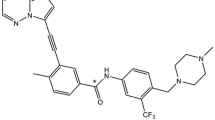Summary
In the rat prednimustine, the prednisolone ester of chlorambucil, is much less toxic than equimolar doses of chlorambucil, when administered subcutaneously (SC). This is due to differences in alkylating agent pharmacokinetics. Prednimustine injected SC produced low plasma concentrations (<5 μM) of the alkylating metabolites chlorambucil and phenyl acetic mustard, which were maintained for 48 h. No unhydrolysed prednimustine could be detected. Chlorambucil, in contrast, was rapidly absorbed, peak levels (40 μM) occurring within 2 h, after which chlorambucil and phenyl acetic mustard plasma levels decreased with half-lives of 2.4 h and 2.9 h respectively.
The toxicity of chlorambucil could be similarly reduced by administering either the methyl ester of clorambucil or by giving chlorambucil in a multiple-treatment low-dose schedule. Neither of these treatments inhibited the Yoshida alkylating agent-resistant tumour, however, whereas prednimustine or a combination of chlorambucil and prednisolone produced significant tumour growth inhibition. Prednisolone did not alter chlorambucil pharmacokinetics. Thus the reduced toxicity of prednimustine is due to chlorambucil esterification and the subsequent alteration in pharmacokinetics, whilst inhibition of alkylating agent-resistant tumours results from the combination of chlorambucil and prednisolone.
Similar content being viewed by others
References
Brandt L, Konyves I, Moller TR (1975) Therapeutic effect of Leo 1031, an alkylating corticosteroid ester, in lymphoproliferative disorders. Acta Med Scand 197:317
Everett J, Roberts J, Ross W (1953) Aryl-2-halogenoalkylamines. XII. Some carboxylic derivatives of N,N-di-2-chloroethyl-aniline. J Chem Soc 2386
Fredholm B, Gunnarsson K, Jensen G, Muntzing J (1978) Mammary tumour inhibition and subacute toxicity in rats of prednimustine and of its molecular components chlorambucil and prednisolone. Acta Pharmacol Toxicol (Copenh) 42:159
Godeneche D, Madelmont JC, Sauvezie B, Billaud A (1975) Etude de la cinétique d'absorption, de distribution et d'élimination de l'acide N,N-dichloro-2,ethyl,p-aminophenyl-4, butyrique (chloraminophène) marqué au 14C chez le rat. Biochem Pharmacol 24:1303
Harrap KR, Riches PG, Gilby ED, Sellwood SM, Wilkinson R, Konyves I (1977) Studies on the toxicity and antitumour activity of prednimustine, a prednisolone ester of chlorambucil. Eur J Cancer 13:873
Harran KR, Jeney A, Thraves PJ, Riches PG, Wilkinson R (1980) Macromolecular targets and metabolic properties of alkylating agents. In: Sartorelli AC (ed) Molecular actions and targets for cancer chemotherapeutic agents. Vol 2. Academic Press, New York, pp 45–84
Hill B, Riches P (1971) The absorption, distribution and excretion of 3H-chlorambucil in rats bearing the Yoshida ascites sarcoma. Br J Cancer 15:831
Jarman M, Griggs L, Tisdale M (1974) Synthesis of tritium-labelled chlorambucil and aniline mustard of high specific activity. J Med Chem 17:194
Konyves I, Liljekvist J (1976) The steroid molecule as a carrier of cytotoxic groups. In: Davis W (ed) Biological characterisation of human tumours. Elsevier, Amsterdam, p 98
McElwain TJ, Toy J, Smith E, Peckham MJ, Austin DE (1977) A combination of chlorambucil, vinblastine, procarbazine and prednisolone for treatment of Hodgkin's disease. Br J Cancer 36:276
McLean A, Newell D, Baker G (1976) The metabolism of chlorambucil. Biochem Pharmacol 23:2331
McLean A, Newell D, Baker G, Connors T (1980) The metabolism of chlorambucil. Biochem Pharmacol 29:2039
Mitoma C, Onidera T, Takegoshi T, Thomas D (1977) Metabolic disposition of chlorambucil in rats. Xenobiotica 7:205
NCS Solubilizer Technical Bulletin A756001 (1975) Searle, Amersham
Newell D, Hart L, Harrap K (1979) Estimation of chlorambucil, phenyl acetic mustard, and prednimustine in human plasma by high-performance liquid chromatography. J Chromatogr 164:114
Sampson J (1969) Non-linear least squares, programme BMDX85. University of California Press, Berkeley, p 177 (University of California Publications in Automatic Computation, no. 3: BMD Biomedical Computer Programs X-Series Supplement)
Sawitsky A, Rai KR, Glidewell O, Silver RT (1977) Comparison of daily versus intermittent chlorambucil and prednisolone therapy in the treatment of patients with chronic lymphocytic leukaemia. Blood 50:1049
Wagner JG (1975) Fundamentals of clinical pharmacokinetics. Drug Intelligence Publications, Hamilton, Ill., p 64
Wilkinson R, Gunnarsson PO, Plym-Forshell G, Renshaw J, Harrap KR (1978) The hydrolysis of prednimustine by enzymes from normal and tumour tissues. In: Davis W, Harrap KR (eds) Advances in tumour prevention detection and characterisation. Excerpta Medica, Amsterdam Oxford, p 260
Wilkinson R, Birbeck M, Harrap KR (1979) Enhancement of the nuclear reactivity of alkylating agents by prednisolone. Cancer Res 39:4256
Author information
Authors and Affiliations
Rights and permissions
About this article
Cite this article
Newell, D.R., Shepherd, C.R. & Harrap, K.R. The pharmacokinetics of prednimustine and chlorambucil in the rat. Cancer Chemother. Pharmacol. 6, 85–91 (1981). https://doi.org/10.1007/BF00253015
Received:
Accepted:
Issue Date:
DOI: https://doi.org/10.1007/BF00253015




